Author Photo And Bio
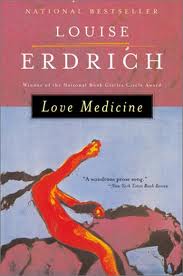 1. Love Medicine by Louise Erdrich (1984). The form of this novel, about two Native American families, reenacts that of a traditional Chippewa Indian story cycle —fourteen stories told by seven characters, forming a collage that forces the reader to sift through and weigh voice against voice, truth against truth. The book’s main story —a long-standing love triangle among a husband and wife and the promiscuous Lulu Lamartine —is often upstaged by Erdrich’s antimythic portrayal of Native Americans cut off from their traditional land, culture, and gods.
1. Love Medicine by Louise Erdrich (1984). The form of this novel, about two Native American families, reenacts that of a traditional Chippewa Indian story cycle —fourteen stories told by seven characters, forming a collage that forces the reader to sift through and weigh voice against voice, truth against truth. The book’s main story —a long-standing love triangle among a husband and wife and the promiscuous Lulu Lamartine —is often upstaged by Erdrich’s antimythic portrayal of Native Americans cut off from their traditional land, culture, and gods.
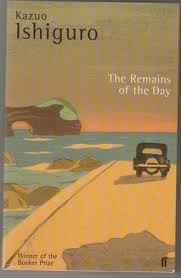 2. The Remains of the Day by Kazuo Ishiguro (1989). During a car trip, Stevens —a career butler who has existed at once on the fringes and within the bird’s nest of the British ruling class —reflects on his lifetime of service to the late Lord Darlington. Blinded by his devotion to “duty,” he cannot admit that his late master was a fascist sympathizer and cannot see that he has forfeited the possibility of leading his own life. Now in old age, Stevens faces a sense of loss without the emotional acuity to comprehend it.
2. The Remains of the Day by Kazuo Ishiguro (1989). During a car trip, Stevens —a career butler who has existed at once on the fringes and within the bird’s nest of the British ruling class —reflects on his lifetime of service to the late Lord Darlington. Blinded by his devotion to “duty,” he cannot admit that his late master was a fascist sympathizer and cannot see that he has forfeited the possibility of leading his own life. Now in old age, Stevens faces a sense of loss without the emotional acuity to comprehend it.
 3. Fiskadoro by Denis Johnson (1985). After a nuclear war devastates the planet, residents of what had been the Florida Keys try to rebuild their lives and communities in a landscape where shards from the obliterated past —religious stories, Jimi Hendrix records, parking decks —remain but are barely understood. By destroying and then rebuilding the world, including the invention of a strange dialect, Johnson’s daring novel probes the nature of communication, memory, and knowledge amid the palpable specter of death.
3. Fiskadoro by Denis Johnson (1985). After a nuclear war devastates the planet, residents of what had been the Florida Keys try to rebuild their lives and communities in a landscape where shards from the obliterated past —religious stories, Jimi Hendrix records, parking decks —remain but are barely understood. By destroying and then rebuilding the world, including the invention of a strange dialect, Johnson’s daring novel probes the nature of communication, memory, and knowledge amid the palpable specter of death.
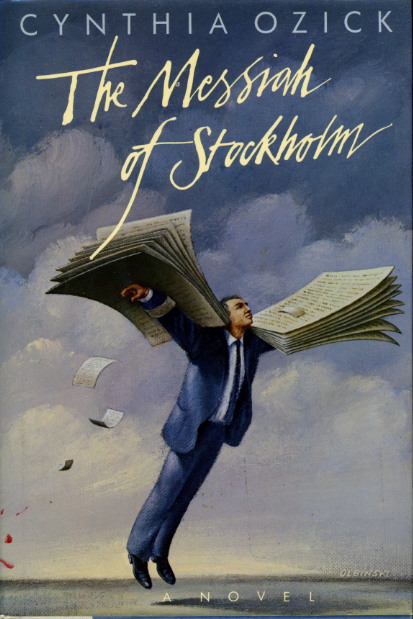 4. The Messiah of Stockholm by Cynthia Ozick (1987). In this novel from Ozick’s mystical period, Lars Andemening, a mousy, fortyish book reviewer for a Swedish daily, has a grandiose fantasy: that he is the son of Bruno Schulz, a Polish writer murdered during World War II by a Nazi officer. But when a woman turns up in Stockholm also claiming to be Schulz’s child and with a copy of Schulz’s long-lost novel The Messiah, Lars’s quest to learn about Schulz turns Oedipal.
4. The Messiah of Stockholm by Cynthia Ozick (1987). In this novel from Ozick’s mystical period, Lars Andemening, a mousy, fortyish book reviewer for a Swedish daily, has a grandiose fantasy: that he is the son of Bruno Schulz, a Polish writer murdered during World War II by a Nazi officer. But when a woman turns up in Stockholm also claiming to be Schulz’s child and with a copy of Schulz’s long-lost novel The Messiah, Lars’s quest to learn about Schulz turns Oedipal.
 5. Lucy by Jamaica Kincaid (1990). Nineteen-year-old Lucy happily leaves her West Indian home and domineering mother to work as an au pair for a well-off and well-meaning American family. But as she develops a new sense of self and independence, she is forced to grapple with life as an outsider, a servant, and a woman of color in a country obsessed with race yet blind to history. Conveyed in Kincaid’s stinging yet poetic prose, Lucy’s awakening illuminates the divides between power and powerlessness, complacency and outrage, comfort and justice.
5. Lucy by Jamaica Kincaid (1990). Nineteen-year-old Lucy happily leaves her West Indian home and domineering mother to work as an au pair for a well-off and well-meaning American family. But as she develops a new sense of self and independence, she is forced to grapple with life as an outsider, a servant, and a woman of color in a country obsessed with race yet blind to history. Conveyed in Kincaid’s stinging yet poetic prose, Lucy’s awakening illuminates the divides between power and powerlessness, complacency and outrage, comfort and justice.
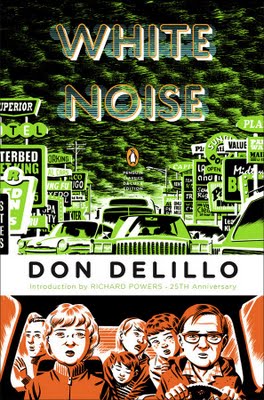 6. White Noise by Don DeLillo (1985). Professor Jack Gladney teaches Hitler studies at the local college and trawls through the tabloid mall of American culture with his pill-popping fourth wife and their four preternaturally knowing children. Then an accident near their town generates a huge poisonous cloud—“an airborne toxic event”—and disrupts their uneasy idyll. This apocalyptic cult classic amusingly and then chillingly captures how media culture has become not just our atmosphere but our food and oxygen.
6. White Noise by Don DeLillo (1985). Professor Jack Gladney teaches Hitler studies at the local college and trawls through the tabloid mall of American culture with his pill-popping fourth wife and their four preternaturally knowing children. Then an accident near their town generates a huge poisonous cloud—“an airborne toxic event”—and disrupts their uneasy idyll. This apocalyptic cult classic amusingly and then chillingly captures how media culture has become not just our atmosphere but our food and oxygen.
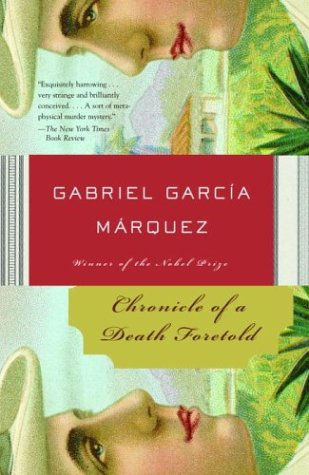 7. Chronicle of a Death Foretold by Gabriel García Márquez (1983). Everyone knows that Santiago Nasar will be murdered by Pedro and Pablo Vicario when the bishop comes to bless their sister’s marriage. The story of Nasar’s last hours is recounted by his cousin, a reporter who returns to the small South American town twenty-seven years later to find out what happened. This quick but densely packed novella looks at how honor and ritual contribute to an entire community’s culpability in a single crime.
7. Chronicle of a Death Foretold by Gabriel García Márquez (1983). Everyone knows that Santiago Nasar will be murdered by Pedro and Pablo Vicario when the bishop comes to bless their sister’s marriage. The story of Nasar’s last hours is recounted by his cousin, a reporter who returns to the small South American town twenty-seven years later to find out what happened. This quick but densely packed novella looks at how honor and ritual contribute to an entire community’s culpability in a single crime.
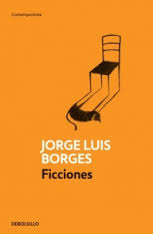 8. Ficciones by Jorge Luis Borges (1944). Few twentieth-century literary works were as influential as Borges’s first collection of surreal “fictions.” Showcasing his deeply serious, brilliantly playful fascination with language, literature, and metaphysics, these seventeen stories—about imaginary books and labyrinthine libraries, cosmic detectives and strange lands—ask us to wonder about how we know what we know (or think we know) while helping light the fuse of postmodern pyrotechnics.
8. Ficciones by Jorge Luis Borges (1944). Few twentieth-century literary works were as influential as Borges’s first collection of surreal “fictions.” Showcasing his deeply serious, brilliantly playful fascination with language, literature, and metaphysics, these seventeen stories—about imaginary books and labyrinthine libraries, cosmic detectives and strange lands—ask us to wonder about how we know what we know (or think we know) while helping light the fuse of postmodern pyrotechnics.
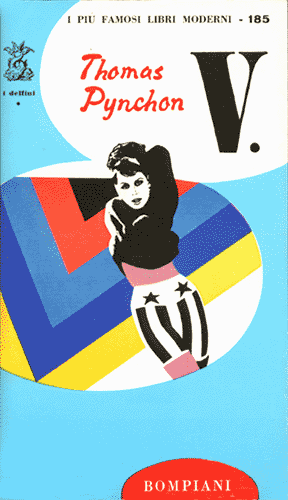 9. V. by Thomas Pynchon (1963). This sprawling postmodern spy novel spiked with Rabelasian humor is ignited by a cryptic line in the journals of Herbert Stencil’s late father: “There is more behind and inside V. than any of us had suspected. Not who, but what: what is she.” The son’s search for the mysterious V.—involving a range of deliciously named characters, including the “schlemiel and human yo-yo” Benny Profane —stretches across three continents and two centuries, bringing Stencil ever closer to the secret powers that have conspired to control, and thereby corrupted, the modern world.
9. V. by Thomas Pynchon (1963). This sprawling postmodern spy novel spiked with Rabelasian humor is ignited by a cryptic line in the journals of Herbert Stencil’s late father: “There is more behind and inside V. than any of us had suspected. Not who, but what: what is she.” The son’s search for the mysterious V.—involving a range of deliciously named characters, including the “schlemiel and human yo-yo” Benny Profane —stretches across three continents and two centuries, bringing Stencil ever closer to the secret powers that have conspired to control, and thereby corrupted, the modern world.
 10. The stories of John Cheever (1912–82). Seemingly confined to recording the self-inflations and petty hypocrisies of suburban WASPs, Cheever’s short fiction actually redefined the story form, mixing minimalism and myth to create uniquely American tragicomedy. A master of the ambiguous ending, Cheever could also be direct: In “The Swimmer,” a man dreams of his family as he blithely “swims” home through his neighbors’ backyard pools, only to collapse at the door of his empty, locked house.
10. The stories of John Cheever (1912–82). Seemingly confined to recording the self-inflations and petty hypocrisies of suburban WASPs, Cheever’s short fiction actually redefined the story form, mixing minimalism and myth to create uniquely American tragicomedy. A master of the ambiguous ending, Cheever could also be direct: In “The Swimmer,” a man dreams of his family as he blithely “swims” home through his neighbors’ backyard pools, only to collapse at the door of his empty, locked house.